Analysis of Social Media Impact on Consumer Buying Behaviour
VerifiedAdded on 2021/02/21
|11
|3184
|64
Report
AI Summary
This report investigates the impact of social media on consumer buying behavior, employing a comprehensive research methodology. The study utilizes both primary and secondary data collection methods, including questionnaires and literature reviews, to gather relevant information. The report details the research methodology, including sampling techniques like simple random sampling, and questionnaire design, incorporating open-ended and closed-ended questions. Data analysis involves qualitative techniques, such as thematic analysis, to interpret consumer responses and buying patterns. Key findings highlight the significant influence of social media marketing on consumer purchasing decisions, emphasizing factors like accessibility, reach, and information availability. The research concludes that social media plays a crucial role in shaping consumer behavior and provides insights into effective marketing strategies.

Paraphrase This Document
Need a fresh take? Get an instant paraphrase of this document with our AI Paraphraser
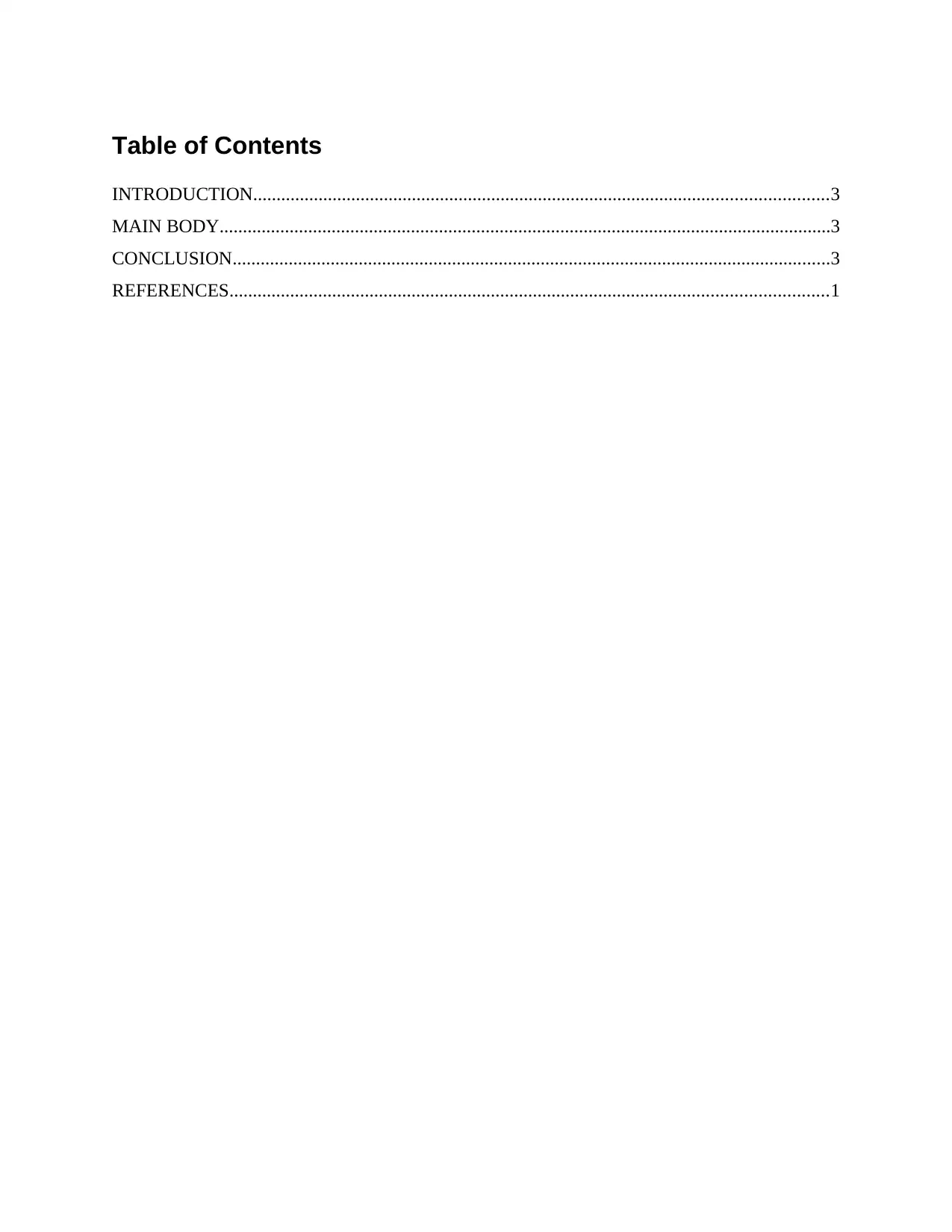
Table of Contents
INTRODUCTION...........................................................................................................................3
MAIN BODY...................................................................................................................................3
CONCLUSION................................................................................................................................3
REFERENCES................................................................................................................................1
INTRODUCTION...........................................................................................................................3
MAIN BODY...................................................................................................................................3
CONCLUSION................................................................................................................................3
REFERENCES................................................................................................................................1
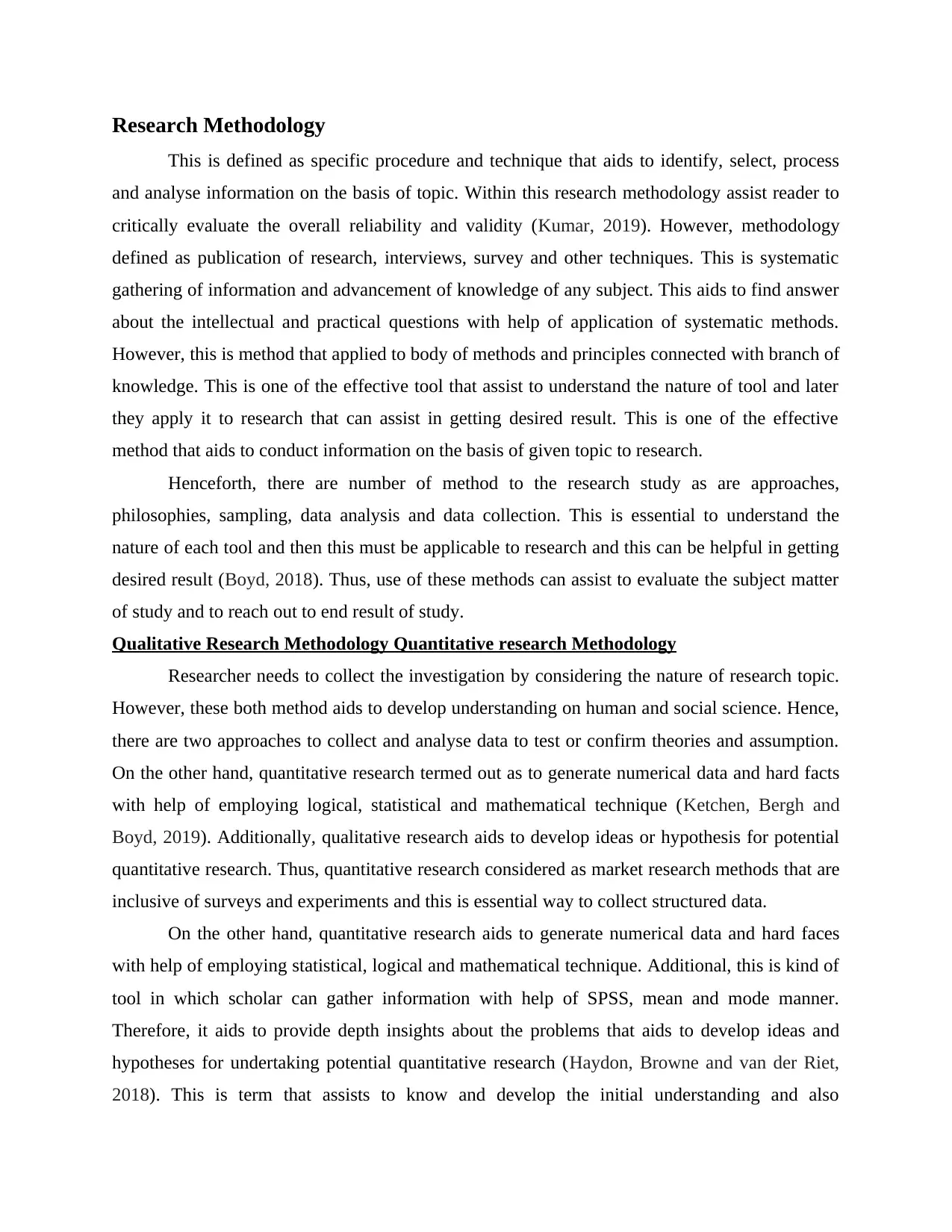
Research Methodology
This is defined as specific procedure and technique that aids to identify, select, process
and analyse information on the basis of topic. Within this research methodology assist reader to
critically evaluate the overall reliability and validity (Kumar, 2019). However, methodology
defined as publication of research, interviews, survey and other techniques. This is systematic
gathering of information and advancement of knowledge of any subject. This aids to find answer
about the intellectual and practical questions with help of application of systematic methods.
However, this is method that applied to body of methods and principles connected with branch of
knowledge. This is one of the effective tool that assist to understand the nature of tool and later
they apply it to research that can assist in getting desired result. This is one of the effective
method that aids to conduct information on the basis of given topic to research.
Henceforth, there are number of method to the research study as are approaches,
philosophies, sampling, data analysis and data collection. This is essential to understand the
nature of each tool and then this must be applicable to research and this can be helpful in getting
desired result (Boyd, 2018). Thus, use of these methods can assist to evaluate the subject matter
of study and to reach out to end result of study.
Qualitative Research Methodology Quantitative research Methodology
Researcher needs to collect the investigation by considering the nature of research topic.
However, these both method aids to develop understanding on human and social science. Hence,
there are two approaches to collect and analyse data to test or confirm theories and assumption.
On the other hand, quantitative research termed out as to generate numerical data and hard facts
with help of employing logical, statistical and mathematical technique (Ketchen, Bergh and
Boyd, 2019). Additionally, qualitative research aids to develop ideas or hypothesis for potential
quantitative research. Thus, quantitative research considered as market research methods that are
inclusive of surveys and experiments and this is essential way to collect structured data.
On the other hand, quantitative research aids to generate numerical data and hard faces
with help of employing statistical, logical and mathematical technique. Additional, this is kind of
tool in which scholar can gather information with help of SPSS, mean and mode manner.
Therefore, it aids to provide depth insights about the problems that aids to develop ideas and
hypotheses for undertaking potential quantitative research (Haydon, Browne and van der Riet,
2018). This is term that assists to know and develop the initial understanding and also
This is defined as specific procedure and technique that aids to identify, select, process
and analyse information on the basis of topic. Within this research methodology assist reader to
critically evaluate the overall reliability and validity (Kumar, 2019). However, methodology
defined as publication of research, interviews, survey and other techniques. This is systematic
gathering of information and advancement of knowledge of any subject. This aids to find answer
about the intellectual and practical questions with help of application of systematic methods.
However, this is method that applied to body of methods and principles connected with branch of
knowledge. This is one of the effective tool that assist to understand the nature of tool and later
they apply it to research that can assist in getting desired result. This is one of the effective
method that aids to conduct information on the basis of given topic to research.
Henceforth, there are number of method to the research study as are approaches,
philosophies, sampling, data analysis and data collection. This is essential to understand the
nature of each tool and then this must be applicable to research and this can be helpful in getting
desired result (Boyd, 2018). Thus, use of these methods can assist to evaluate the subject matter
of study and to reach out to end result of study.
Qualitative Research Methodology Quantitative research Methodology
Researcher needs to collect the investigation by considering the nature of research topic.
However, these both method aids to develop understanding on human and social science. Hence,
there are two approaches to collect and analyse data to test or confirm theories and assumption.
On the other hand, quantitative research termed out as to generate numerical data and hard facts
with help of employing logical, statistical and mathematical technique (Ketchen, Bergh and
Boyd, 2019). Additionally, qualitative research aids to develop ideas or hypothesis for potential
quantitative research. Thus, quantitative research considered as market research methods that are
inclusive of surveys and experiments and this is essential way to collect structured data.
On the other hand, quantitative research aids to generate numerical data and hard faces
with help of employing statistical, logical and mathematical technique. Additional, this is kind of
tool in which scholar can gather information with help of SPSS, mean and mode manner.
Therefore, it aids to provide depth insights about the problems that aids to develop ideas and
hypotheses for undertaking potential quantitative research (Haydon, Browne and van der Riet,
2018). This is term that assists to know and develop the initial understanding and also
⊘ This is a preview!⊘
Do you want full access?
Subscribe today to unlock all pages.

Trusted by 1+ million students worldwide
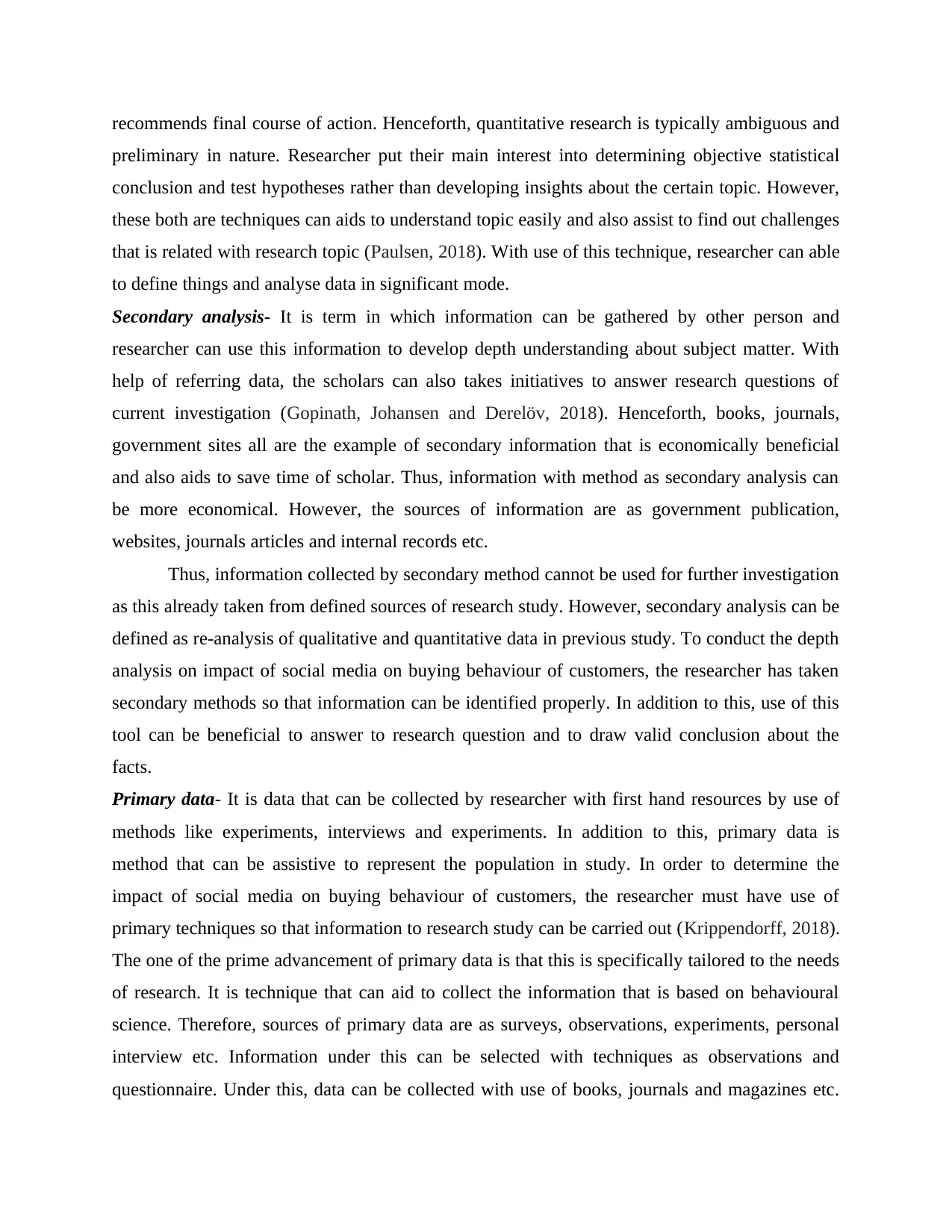
recommends final course of action. Henceforth, quantitative research is typically ambiguous and
preliminary in nature. Researcher put their main interest into determining objective statistical
conclusion and test hypotheses rather than developing insights about the certain topic. However,
these both are techniques can aids to understand topic easily and also assist to find out challenges
that is related with research topic (Paulsen, 2018). With use of this technique, researcher can able
to define things and analyse data in significant mode.
Secondary analysis- It is term in which information can be gathered by other person and
researcher can use this information to develop depth understanding about subject matter. With
help of referring data, the scholars can also takes initiatives to answer research questions of
current investigation (Gopinath, Johansen and Derelöv, 2018). Henceforth, books, journals,
government sites all are the example of secondary information that is economically beneficial
and also aids to save time of scholar. Thus, information with method as secondary analysis can
be more economical. However, the sources of information are as government publication,
websites, journals articles and internal records etc.
Thus, information collected by secondary method cannot be used for further investigation
as this already taken from defined sources of research study. However, secondary analysis can be
defined as re-analysis of qualitative and quantitative data in previous study. To conduct the depth
analysis on impact of social media on buying behaviour of customers, the researcher has taken
secondary methods so that information can be identified properly. In addition to this, use of this
tool can be beneficial to answer to research question and to draw valid conclusion about the
facts.
Primary data- It is data that can be collected by researcher with first hand resources by use of
methods like experiments, interviews and experiments. In addition to this, primary data is
method that can be assistive to represent the population in study. In order to determine the
impact of social media on buying behaviour of customers, the researcher must have use of
primary techniques so that information to research study can be carried out (Krippendorff, 2018).
The one of the prime advancement of primary data is that this is specifically tailored to the needs
of research. It is technique that can aid to collect the information that is based on behavioural
science. Therefore, sources of primary data are as surveys, observations, experiments, personal
interview etc. Information under this can be selected with techniques as observations and
questionnaire. Under this, data can be collected with use of books, journals and magazines etc.
preliminary in nature. Researcher put their main interest into determining objective statistical
conclusion and test hypotheses rather than developing insights about the certain topic. However,
these both are techniques can aids to understand topic easily and also assist to find out challenges
that is related with research topic (Paulsen, 2018). With use of this technique, researcher can able
to define things and analyse data in significant mode.
Secondary analysis- It is term in which information can be gathered by other person and
researcher can use this information to develop depth understanding about subject matter. With
help of referring data, the scholars can also takes initiatives to answer research questions of
current investigation (Gopinath, Johansen and Derelöv, 2018). Henceforth, books, journals,
government sites all are the example of secondary information that is economically beneficial
and also aids to save time of scholar. Thus, information with method as secondary analysis can
be more economical. However, the sources of information are as government publication,
websites, journals articles and internal records etc.
Thus, information collected by secondary method cannot be used for further investigation
as this already taken from defined sources of research study. However, secondary analysis can be
defined as re-analysis of qualitative and quantitative data in previous study. To conduct the depth
analysis on impact of social media on buying behaviour of customers, the researcher has taken
secondary methods so that information can be identified properly. In addition to this, use of this
tool can be beneficial to answer to research question and to draw valid conclusion about the
facts.
Primary data- It is data that can be collected by researcher with first hand resources by use of
methods like experiments, interviews and experiments. In addition to this, primary data is
method that can be assistive to represent the population in study. In order to determine the
impact of social media on buying behaviour of customers, the researcher must have use of
primary techniques so that information to research study can be carried out (Krippendorff, 2018).
The one of the prime advancement of primary data is that this is specifically tailored to the needs
of research. It is technique that can aid to collect the information that is based on behavioural
science. Therefore, sources of primary data are as surveys, observations, experiments, personal
interview etc. Information under this can be selected with techniques as observations and
questionnaire. Under this, data can be collected with use of books, journals and magazines etc.
Paraphrase This Document
Need a fresh take? Get an instant paraphrase of this document with our AI Paraphraser
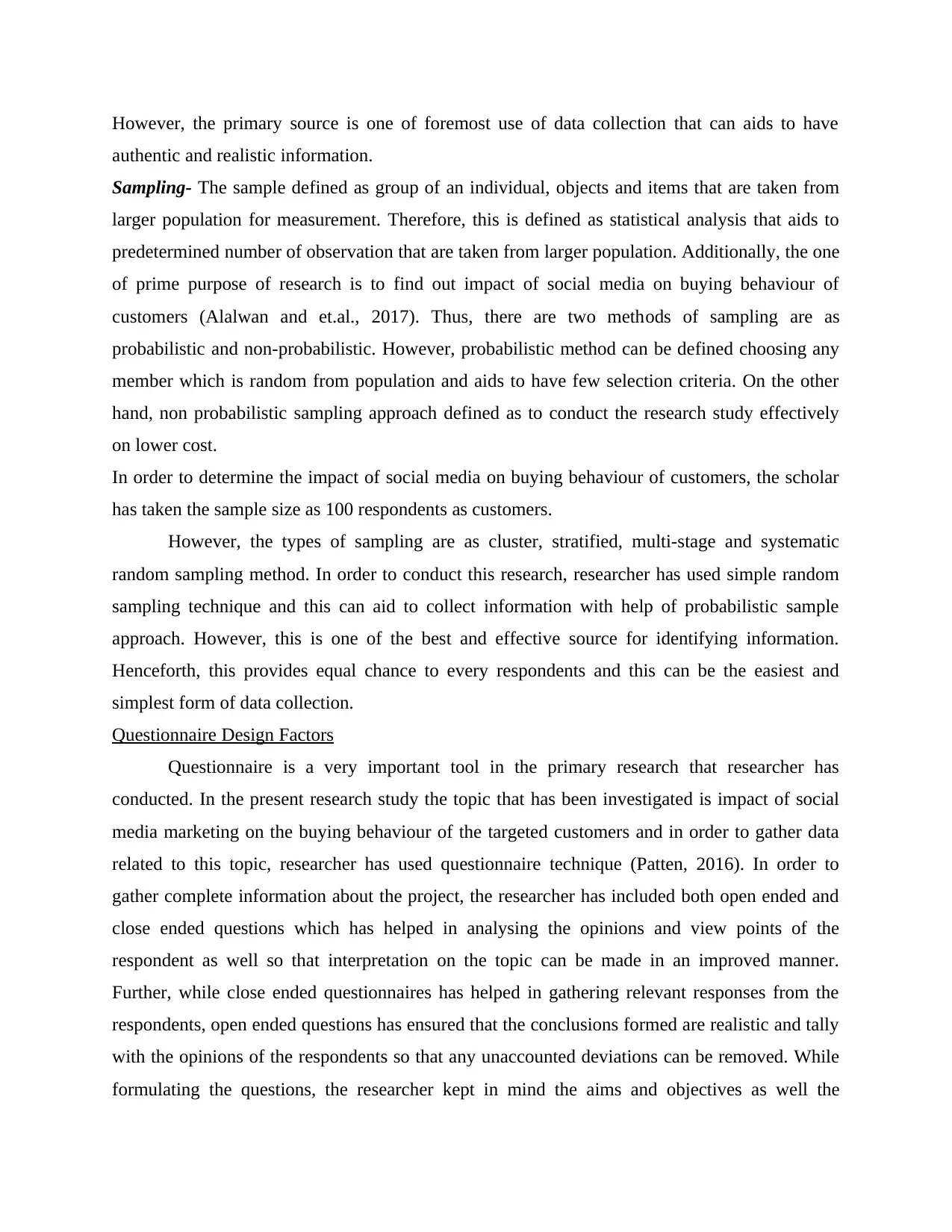
However, the primary source is one of foremost use of data collection that can aids to have
authentic and realistic information.
Sampling- The sample defined as group of an individual, objects and items that are taken from
larger population for measurement. Therefore, this is defined as statistical analysis that aids to
predetermined number of observation that are taken from larger population. Additionally, the one
of prime purpose of research is to find out impact of social media on buying behaviour of
customers (Alalwan and et.al., 2017). Thus, there are two methods of sampling are as
probabilistic and non-probabilistic. However, probabilistic method can be defined choosing any
member which is random from population and aids to have few selection criteria. On the other
hand, non probabilistic sampling approach defined as to conduct the research study effectively
on lower cost.
In order to determine the impact of social media on buying behaviour of customers, the scholar
has taken the sample size as 100 respondents as customers.
However, the types of sampling are as cluster, stratified, multi-stage and systematic
random sampling method. In order to conduct this research, researcher has used simple random
sampling technique and this can aid to collect information with help of probabilistic sample
approach. However, this is one of the best and effective source for identifying information.
Henceforth, this provides equal chance to every respondents and this can be the easiest and
simplest form of data collection.
Questionnaire Design Factors
Questionnaire is a very important tool in the primary research that researcher has
conducted. In the present research study the topic that has been investigated is impact of social
media marketing on the buying behaviour of the targeted customers and in order to gather data
related to this topic, researcher has used questionnaire technique (Patten, 2016). In order to
gather complete information about the project, the researcher has included both open ended and
close ended questions which has helped in analysing the opinions and view points of the
respondent as well so that interpretation on the topic can be made in an improved manner.
Further, while close ended questionnaires has helped in gathering relevant responses from the
respondents, open ended questions has ensured that the conclusions formed are realistic and tally
with the opinions of the respondents so that any unaccounted deviations can be removed. While
formulating the questions, the researcher kept in mind the aims and objectives as well the
authentic and realistic information.
Sampling- The sample defined as group of an individual, objects and items that are taken from
larger population for measurement. Therefore, this is defined as statistical analysis that aids to
predetermined number of observation that are taken from larger population. Additionally, the one
of prime purpose of research is to find out impact of social media on buying behaviour of
customers (Alalwan and et.al., 2017). Thus, there are two methods of sampling are as
probabilistic and non-probabilistic. However, probabilistic method can be defined choosing any
member which is random from population and aids to have few selection criteria. On the other
hand, non probabilistic sampling approach defined as to conduct the research study effectively
on lower cost.
In order to determine the impact of social media on buying behaviour of customers, the scholar
has taken the sample size as 100 respondents as customers.
However, the types of sampling are as cluster, stratified, multi-stage and systematic
random sampling method. In order to conduct this research, researcher has used simple random
sampling technique and this can aid to collect information with help of probabilistic sample
approach. However, this is one of the best and effective source for identifying information.
Henceforth, this provides equal chance to every respondents and this can be the easiest and
simplest form of data collection.
Questionnaire Design Factors
Questionnaire is a very important tool in the primary research that researcher has
conducted. In the present research study the topic that has been investigated is impact of social
media marketing on the buying behaviour of the targeted customers and in order to gather data
related to this topic, researcher has used questionnaire technique (Patten, 2016). In order to
gather complete information about the project, the researcher has included both open ended and
close ended questions which has helped in analysing the opinions and view points of the
respondent as well so that interpretation on the topic can be made in an improved manner.
Further, while close ended questionnaires has helped in gathering relevant responses from the
respondents, open ended questions has ensured that the conclusions formed are realistic and tally
with the opinions of the respondents so that any unaccounted deviations can be removed. While
formulating the questions, the researcher kept in mind the aims and objectives as well the
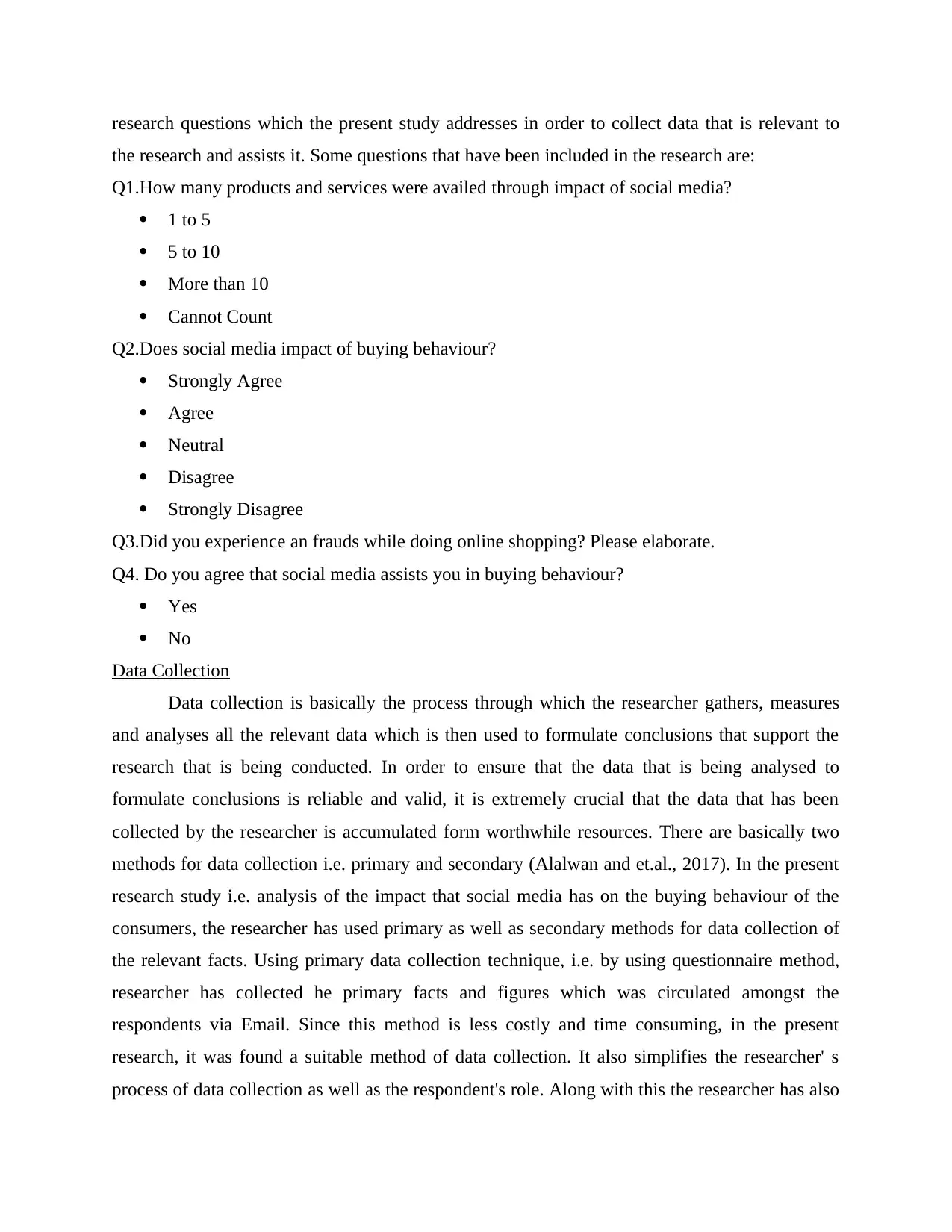
research questions which the present study addresses in order to collect data that is relevant to
the research and assists it. Some questions that have been included in the research are:
Q1.How many products and services were availed through impact of social media?
1 to 5
5 to 10
More than 10
Cannot Count
Q2.Does social media impact of buying behaviour?
Strongly Agree
Agree
Neutral
Disagree
Strongly Disagree
Q3.Did you experience an frauds while doing online shopping? Please elaborate.
Q4. Do you agree that social media assists you in buying behaviour?
Yes
No
Data Collection
Data collection is basically the process through which the researcher gathers, measures
and analyses all the relevant data which is then used to formulate conclusions that support the
research that is being conducted. In order to ensure that the data that is being analysed to
formulate conclusions is reliable and valid, it is extremely crucial that the data that has been
collected by the researcher is accumulated form worthwhile resources. There are basically two
methods for data collection i.e. primary and secondary (Alalwan and et.al., 2017). In the present
research study i.e. analysis of the impact that social media has on the buying behaviour of the
consumers, the researcher has used primary as well as secondary methods for data collection of
the relevant facts. Using primary data collection technique, i.e. by using questionnaire method,
researcher has collected he primary facts and figures which was circulated amongst the
respondents via Email. Since this method is less costly and time consuming, in the present
research, it was found a suitable method of data collection. It also simplifies the researcher' s
process of data collection as well as the respondent's role. Along with this the researcher has also
the research and assists it. Some questions that have been included in the research are:
Q1.How many products and services were availed through impact of social media?
1 to 5
5 to 10
More than 10
Cannot Count
Q2.Does social media impact of buying behaviour?
Strongly Agree
Agree
Neutral
Disagree
Strongly Disagree
Q3.Did you experience an frauds while doing online shopping? Please elaborate.
Q4. Do you agree that social media assists you in buying behaviour?
Yes
No
Data Collection
Data collection is basically the process through which the researcher gathers, measures
and analyses all the relevant data which is then used to formulate conclusions that support the
research that is being conducted. In order to ensure that the data that is being analysed to
formulate conclusions is reliable and valid, it is extremely crucial that the data that has been
collected by the researcher is accumulated form worthwhile resources. There are basically two
methods for data collection i.e. primary and secondary (Alalwan and et.al., 2017). In the present
research study i.e. analysis of the impact that social media has on the buying behaviour of the
consumers, the researcher has used primary as well as secondary methods for data collection of
the relevant facts. Using primary data collection technique, i.e. by using questionnaire method,
researcher has collected he primary facts and figures which was circulated amongst the
respondents via Email. Since this method is less costly and time consuming, in the present
research, it was found a suitable method of data collection. It also simplifies the researcher' s
process of data collection as well as the respondent's role. Along with this the researcher has also
⊘ This is a preview!⊘
Do you want full access?
Subscribe today to unlock all pages.

Trusted by 1+ million students worldwide
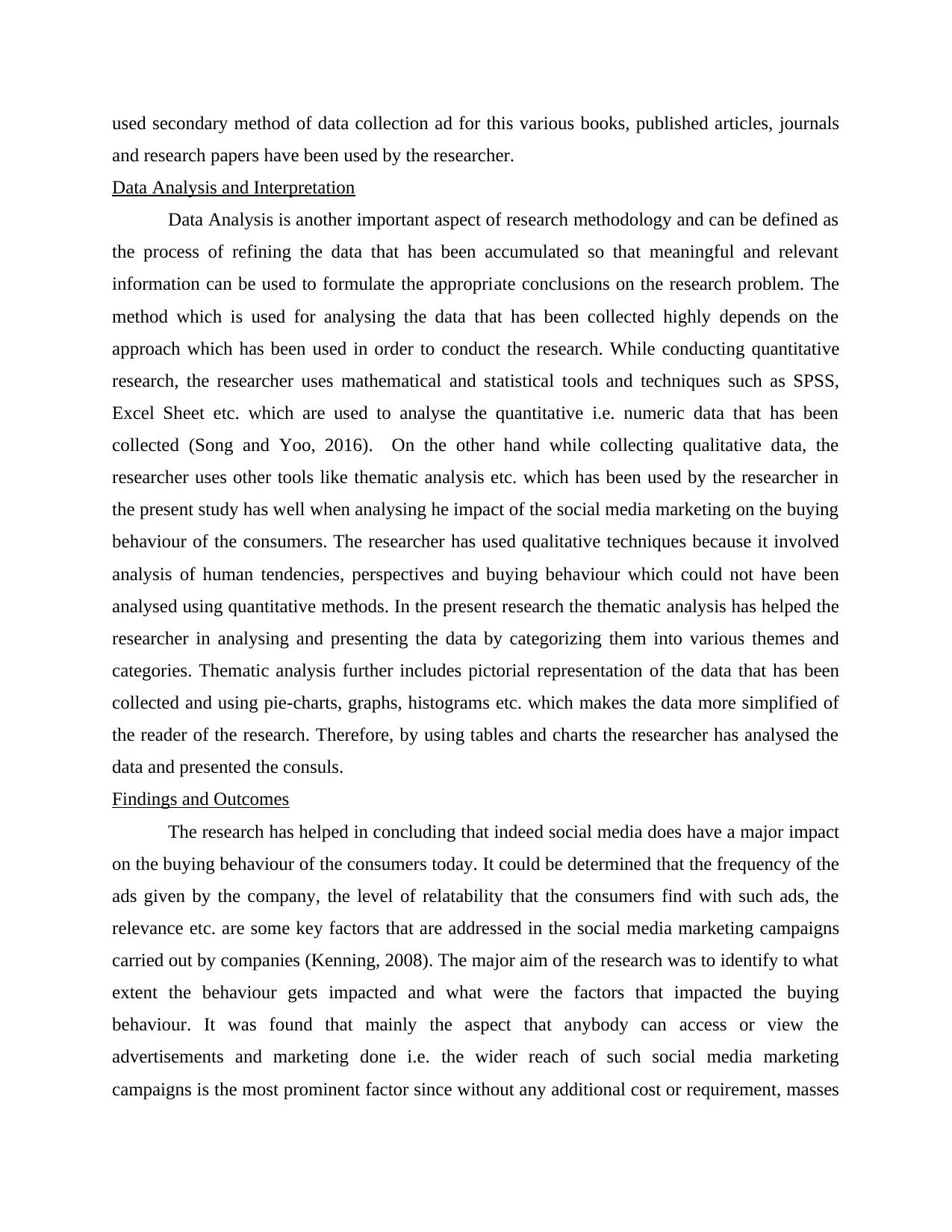
used secondary method of data collection ad for this various books, published articles, journals
and research papers have been used by the researcher.
Data Analysis and Interpretation
Data Analysis is another important aspect of research methodology and can be defined as
the process of refining the data that has been accumulated so that meaningful and relevant
information can be used to formulate the appropriate conclusions on the research problem. The
method which is used for analysing the data that has been collected highly depends on the
approach which has been used in order to conduct the research. While conducting quantitative
research, the researcher uses mathematical and statistical tools and techniques such as SPSS,
Excel Sheet etc. which are used to analyse the quantitative i.e. numeric data that has been
collected (Song and Yoo, 2016). On the other hand while collecting qualitative data, the
researcher uses other tools like thematic analysis etc. which has been used by the researcher in
the present study has well when analysing he impact of the social media marketing on the buying
behaviour of the consumers. The researcher has used qualitative techniques because it involved
analysis of human tendencies, perspectives and buying behaviour which could not have been
analysed using quantitative methods. In the present research the thematic analysis has helped the
researcher in analysing and presenting the data by categorizing them into various themes and
categories. Thematic analysis further includes pictorial representation of the data that has been
collected and using pie-charts, graphs, histograms etc. which makes the data more simplified of
the reader of the research. Therefore, by using tables and charts the researcher has analysed the
data and presented the consuls.
Findings and Outcomes
The research has helped in concluding that indeed social media does have a major impact
on the buying behaviour of the consumers today. It could be determined that the frequency of the
ads given by the company, the level of relatability that the consumers find with such ads, the
relevance etc. are some key factors that are addressed in the social media marketing campaigns
carried out by companies (Kenning, 2008). The major aim of the research was to identify to what
extent the behaviour gets impacted and what were the factors that impacted the buying
behaviour. It was found that mainly the aspect that anybody can access or view the
advertisements and marketing done i.e. the wider reach of such social media marketing
campaigns is the most prominent factor since without any additional cost or requirement, masses
and research papers have been used by the researcher.
Data Analysis and Interpretation
Data Analysis is another important aspect of research methodology and can be defined as
the process of refining the data that has been accumulated so that meaningful and relevant
information can be used to formulate the appropriate conclusions on the research problem. The
method which is used for analysing the data that has been collected highly depends on the
approach which has been used in order to conduct the research. While conducting quantitative
research, the researcher uses mathematical and statistical tools and techniques such as SPSS,
Excel Sheet etc. which are used to analyse the quantitative i.e. numeric data that has been
collected (Song and Yoo, 2016). On the other hand while collecting qualitative data, the
researcher uses other tools like thematic analysis etc. which has been used by the researcher in
the present study has well when analysing he impact of the social media marketing on the buying
behaviour of the consumers. The researcher has used qualitative techniques because it involved
analysis of human tendencies, perspectives and buying behaviour which could not have been
analysed using quantitative methods. In the present research the thematic analysis has helped the
researcher in analysing and presenting the data by categorizing them into various themes and
categories. Thematic analysis further includes pictorial representation of the data that has been
collected and using pie-charts, graphs, histograms etc. which makes the data more simplified of
the reader of the research. Therefore, by using tables and charts the researcher has analysed the
data and presented the consuls.
Findings and Outcomes
The research has helped in concluding that indeed social media does have a major impact
on the buying behaviour of the consumers today. It could be determined that the frequency of the
ads given by the company, the level of relatability that the consumers find with such ads, the
relevance etc. are some key factors that are addressed in the social media marketing campaigns
carried out by companies (Kenning, 2008). The major aim of the research was to identify to what
extent the behaviour gets impacted and what were the factors that impacted the buying
behaviour. It was found that mainly the aspect that anybody can access or view the
advertisements and marketing done i.e. the wider reach of such social media marketing
campaigns is the most prominent factor since without any additional cost or requirement, masses
Paraphrase This Document
Need a fresh take? Get an instant paraphrase of this document with our AI Paraphraser
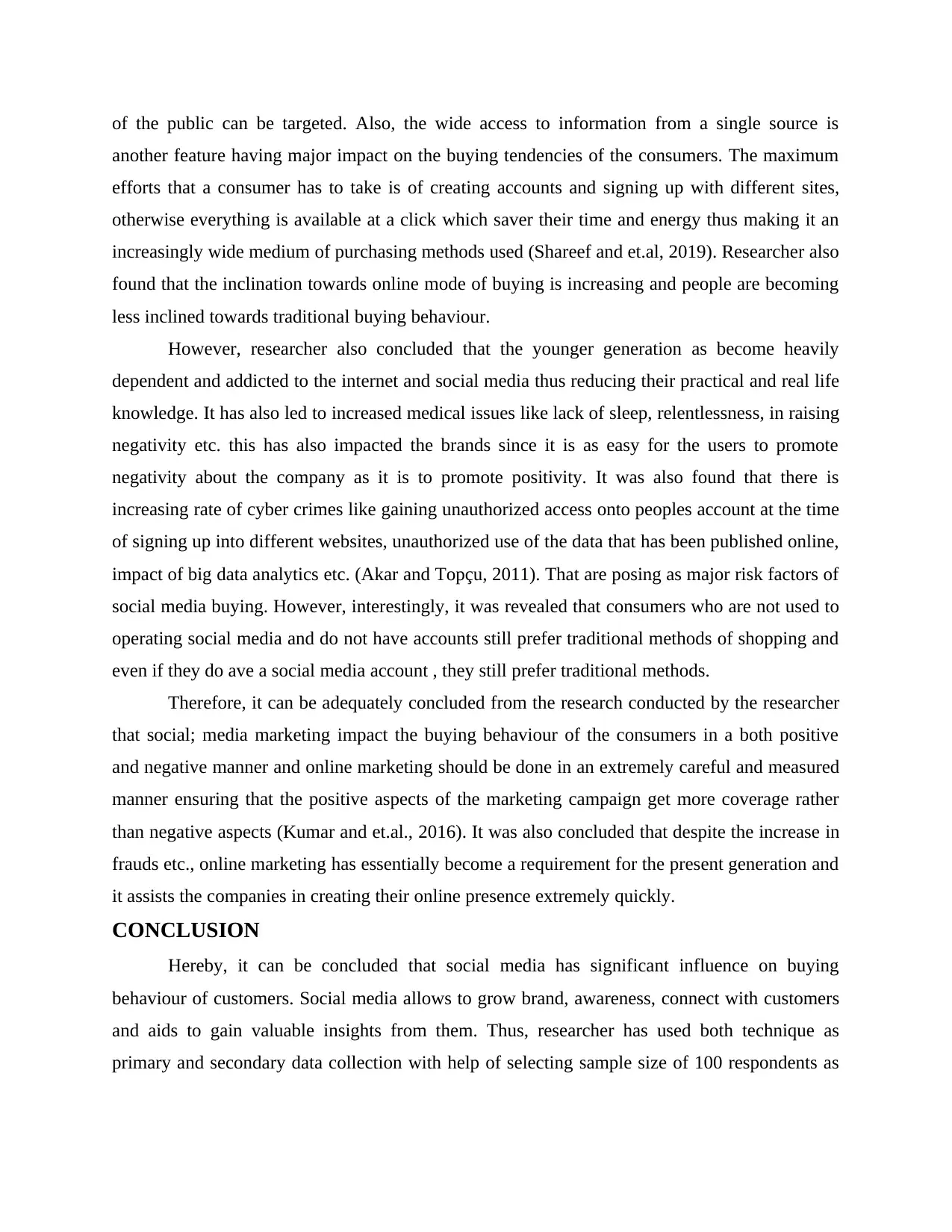
of the public can be targeted. Also, the wide access to information from a single source is
another feature having major impact on the buying tendencies of the consumers. The maximum
efforts that a consumer has to take is of creating accounts and signing up with different sites,
otherwise everything is available at a click which saver their time and energy thus making it an
increasingly wide medium of purchasing methods used (Shareef and et.al, 2019). Researcher also
found that the inclination towards online mode of buying is increasing and people are becoming
less inclined towards traditional buying behaviour.
However, researcher also concluded that the younger generation as become heavily
dependent and addicted to the internet and social media thus reducing their practical and real life
knowledge. It has also led to increased medical issues like lack of sleep, relentlessness, in raising
negativity etc. this has also impacted the brands since it is as easy for the users to promote
negativity about the company as it is to promote positivity. It was also found that there is
increasing rate of cyber crimes like gaining unauthorized access onto peoples account at the time
of signing up into different websites, unauthorized use of the data that has been published online,
impact of big data analytics etc. (Akar and Topçu, 2011). That are posing as major risk factors of
social media buying. However, interestingly, it was revealed that consumers who are not used to
operating social media and do not have accounts still prefer traditional methods of shopping and
even if they do ave a social media account , they still prefer traditional methods.
Therefore, it can be adequately concluded from the research conducted by the researcher
that social; media marketing impact the buying behaviour of the consumers in a both positive
and negative manner and online marketing should be done in an extremely careful and measured
manner ensuring that the positive aspects of the marketing campaign get more coverage rather
than negative aspects (Kumar and et.al., 2016). It was also concluded that despite the increase in
frauds etc., online marketing has essentially become a requirement for the present generation and
it assists the companies in creating their online presence extremely quickly.
CONCLUSION
Hereby, it can be concluded that social media has significant influence on buying
behaviour of customers. Social media allows to grow brand, awareness, connect with customers
and aids to gain valuable insights from them. Thus, researcher has used both technique as
primary and secondary data collection with help of selecting sample size of 100 respondents as
another feature having major impact on the buying tendencies of the consumers. The maximum
efforts that a consumer has to take is of creating accounts and signing up with different sites,
otherwise everything is available at a click which saver their time and energy thus making it an
increasingly wide medium of purchasing methods used (Shareef and et.al, 2019). Researcher also
found that the inclination towards online mode of buying is increasing and people are becoming
less inclined towards traditional buying behaviour.
However, researcher also concluded that the younger generation as become heavily
dependent and addicted to the internet and social media thus reducing their practical and real life
knowledge. It has also led to increased medical issues like lack of sleep, relentlessness, in raising
negativity etc. this has also impacted the brands since it is as easy for the users to promote
negativity about the company as it is to promote positivity. It was also found that there is
increasing rate of cyber crimes like gaining unauthorized access onto peoples account at the time
of signing up into different websites, unauthorized use of the data that has been published online,
impact of big data analytics etc. (Akar and Topçu, 2011). That are posing as major risk factors of
social media buying. However, interestingly, it was revealed that consumers who are not used to
operating social media and do not have accounts still prefer traditional methods of shopping and
even if they do ave a social media account , they still prefer traditional methods.
Therefore, it can be adequately concluded from the research conducted by the researcher
that social; media marketing impact the buying behaviour of the consumers in a both positive
and negative manner and online marketing should be done in an extremely careful and measured
manner ensuring that the positive aspects of the marketing campaign get more coverage rather
than negative aspects (Kumar and et.al., 2016). It was also concluded that despite the increase in
frauds etc., online marketing has essentially become a requirement for the present generation and
it assists the companies in creating their online presence extremely quickly.
CONCLUSION
Hereby, it can be concluded that social media has significant influence on buying
behaviour of customers. Social media allows to grow brand, awareness, connect with customers
and aids to gain valuable insights from them. Thus, researcher has used both technique as
primary and secondary data collection with help of selecting sample size of 100 respondents as

customers. On the other hand, researcher has used simple random technique in which 100
consumer has chosen to get reviews about the impact of social media.
Additionally, it has been concluded that there is huge number of internet users that result
into directly promote social media approach to analyse the impact on buying behaviour of
customers.
consumer has chosen to get reviews about the impact of social media.
Additionally, it has been concluded that there is huge number of internet users that result
into directly promote social media approach to analyse the impact on buying behaviour of
customers.
⊘ This is a preview!⊘
Do you want full access?
Subscribe today to unlock all pages.

Trusted by 1+ million students worldwide
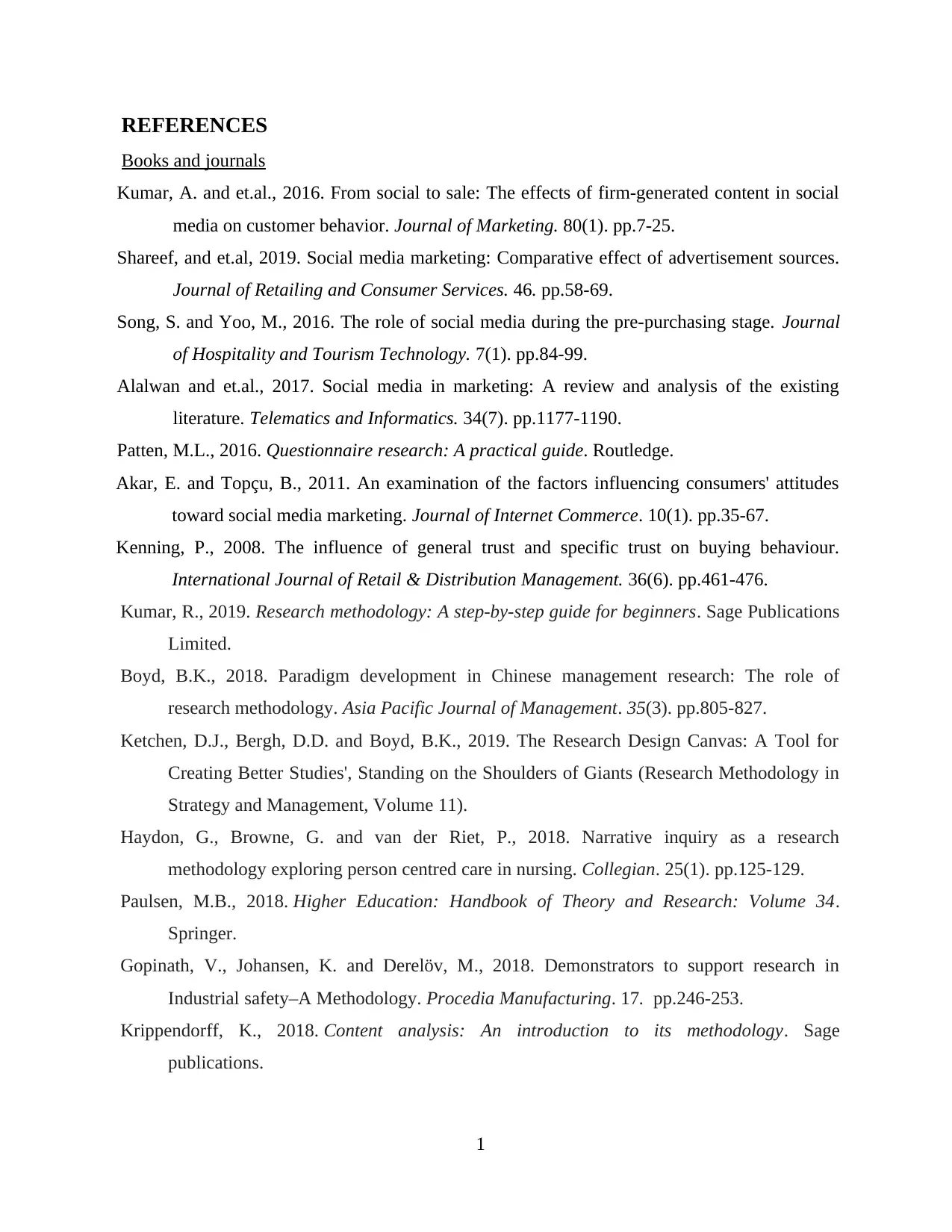
REFERENCES
Books and journals
Kumar, A. and et.al., 2016. From social to sale: The effects of firm-generated content in social
media on customer behavior. Journal of Marketing. 80(1). pp.7-25.
Shareef, and et.al, 2019. Social media marketing: Comparative effect of advertisement sources.
Journal of Retailing and Consumer Services. 46. pp.58-69.
Song, S. and Yoo, M., 2016. The role of social media during the pre-purchasing stage. Journal
of Hospitality and Tourism Technology. 7(1). pp.84-99.
Alalwan and et.al., 2017. Social media in marketing: A review and analysis of the existing
literature. Telematics and Informatics. 34(7). pp.1177-1190.
Patten, M.L., 2016. Questionnaire research: A practical guide. Routledge.
Akar, E. and Topçu, B., 2011. An examination of the factors influencing consumers' attitudes
toward social media marketing. Journal of Internet Commerce. 10(1). pp.35-67.
Kenning, P., 2008. The influence of general trust and specific trust on buying behaviour.
International Journal of Retail & Distribution Management. 36(6). pp.461-476.
Kumar, R., 2019. Research methodology: A step-by-step guide for beginners. Sage Publications
Limited.
Boyd, B.K., 2018. Paradigm development in Chinese management research: The role of
research methodology. Asia Pacific Journal of Management. 35(3). pp.805-827.
Ketchen, D.J., Bergh, D.D. and Boyd, B.K., 2019. The Research Design Canvas: A Tool for
Creating Better Studies', Standing on the Shoulders of Giants (Research Methodology in
Strategy and Management, Volume 11).
Haydon, G., Browne, G. and van der Riet, P., 2018. Narrative inquiry as a research
methodology exploring person centred care in nursing. Collegian. 25(1). pp.125-129.
Paulsen, M.B., 2018. Higher Education: Handbook of Theory and Research: Volume 34.
Springer.
Gopinath, V., Johansen, K. and Derelöv, M., 2018. Demonstrators to support research in
Industrial safety–A Methodology. Procedia Manufacturing. 17. pp.246-253.
Krippendorff, K., 2018. Content analysis: An introduction to its methodology. Sage
publications.
1
Books and journals
Kumar, A. and et.al., 2016. From social to sale: The effects of firm-generated content in social
media on customer behavior. Journal of Marketing. 80(1). pp.7-25.
Shareef, and et.al, 2019. Social media marketing: Comparative effect of advertisement sources.
Journal of Retailing and Consumer Services. 46. pp.58-69.
Song, S. and Yoo, M., 2016. The role of social media during the pre-purchasing stage. Journal
of Hospitality and Tourism Technology. 7(1). pp.84-99.
Alalwan and et.al., 2017. Social media in marketing: A review and analysis of the existing
literature. Telematics and Informatics. 34(7). pp.1177-1190.
Patten, M.L., 2016. Questionnaire research: A practical guide. Routledge.
Akar, E. and Topçu, B., 2011. An examination of the factors influencing consumers' attitudes
toward social media marketing. Journal of Internet Commerce. 10(1). pp.35-67.
Kenning, P., 2008. The influence of general trust and specific trust on buying behaviour.
International Journal of Retail & Distribution Management. 36(6). pp.461-476.
Kumar, R., 2019. Research methodology: A step-by-step guide for beginners. Sage Publications
Limited.
Boyd, B.K., 2018. Paradigm development in Chinese management research: The role of
research methodology. Asia Pacific Journal of Management. 35(3). pp.805-827.
Ketchen, D.J., Bergh, D.D. and Boyd, B.K., 2019. The Research Design Canvas: A Tool for
Creating Better Studies', Standing on the Shoulders of Giants (Research Methodology in
Strategy and Management, Volume 11).
Haydon, G., Browne, G. and van der Riet, P., 2018. Narrative inquiry as a research
methodology exploring person centred care in nursing. Collegian. 25(1). pp.125-129.
Paulsen, M.B., 2018. Higher Education: Handbook of Theory and Research: Volume 34.
Springer.
Gopinath, V., Johansen, K. and Derelöv, M., 2018. Demonstrators to support research in
Industrial safety–A Methodology. Procedia Manufacturing. 17. pp.246-253.
Krippendorff, K., 2018. Content analysis: An introduction to its methodology. Sage
publications.
1
Paraphrase This Document
Need a fresh take? Get an instant paraphrase of this document with our AI Paraphraser

Sim, J., Saunders, B., Waterfield, J. and Kingstone, T., 2018. Can sample size in qualitative
research be determined a priori?. International Journal of Social Research
Methodology, 21(5), pp.619-634.
2
research be determined a priori?. International Journal of Social Research
Methodology, 21(5), pp.619-634.
2
1 out of 11
Related Documents
Your All-in-One AI-Powered Toolkit for Academic Success.
+13062052269
info@desklib.com
Available 24*7 on WhatsApp / Email
![[object Object]](/_next/static/media/star-bottom.7253800d.svg)
Unlock your academic potential
Copyright © 2020–2025 A2Z Services. All Rights Reserved. Developed and managed by ZUCOL.





